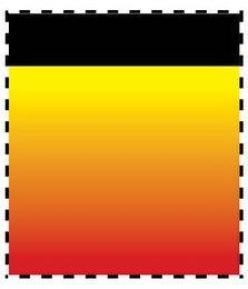 On April 8, 2020, the Court of Appeals for the Federal Circuit issued a decision on an appeal from the refusal of registration of a color trademark by the Trademark Trial and Appeal Board. In this case, the applicant, Forney Industries, Inc., a maker of welding and machining tools and accessories, filed a trademark application in the U.S. Patent and Trademark Office based on use in commerce of the color mark shown above, which Forney features on its product packaging. The Examining Attorney rejected the application on the ground that the mark was not inherently distinctive – and so not immediately eligible for registration – and only registrable on the Supplemental Register (the secondary register of the USPTO for marks potentially capable of acquiring distinctiveness), or on the Principal Register with adequate evidence of acquired distinctiveness. On appeal of the Examiner’s decision by Forney, the TTAB affirmed the refusal of registration, rejecting Forney’s argument that its proposed mark was inherently distinctive product packaging trade dress that was registrable without further proof. Forney subsequently appealed the Board’s decision to the CAFC.
On April 8, 2020, the Court of Appeals for the Federal Circuit issued a decision on an appeal from the refusal of registration of a color trademark by the Trademark Trial and Appeal Board. In this case, the applicant, Forney Industries, Inc., a maker of welding and machining tools and accessories, filed a trademark application in the U.S. Patent and Trademark Office based on use in commerce of the color mark shown above, which Forney features on its product packaging. The Examining Attorney rejected the application on the ground that the mark was not inherently distinctive – and so not immediately eligible for registration – and only registrable on the Supplemental Register (the secondary register of the USPTO for marks potentially capable of acquiring distinctiveness), or on the Principal Register with adequate evidence of acquired distinctiveness. On appeal of the Examiner’s decision by Forney, the TTAB affirmed the refusal of registration, rejecting Forney’s argument that its proposed mark was inherently distinctive product packaging trade dress that was registrable without further proof. Forney subsequently appealed the Board’s decision to the CAFC.
The CAFC vacated the TTAB’s determination that the color trademark as applied for was not inherently distinctive, and remanded the case to the TTAB for further consideration.
The question the TTAB must now answer is whether, as used on product packaging, a mark consisting of a combination of colors, and the design those colors create, is sufficiently indicative of the source of the goods contained in that packaging, and thus inherently distinctive.
The CAFC looked to three Supreme Court decisions that are seminal to the analysis of trademark protection for trade dress, color trademarks, product design, and product packaging, and reflect the long and complicated history in this area of U.S. trademark law:
- Two Pesos, Inc. v. Taco Cabana, Inc., 505 U.S. 763 (1992) — Holding that product packaging, i.e., trade dress, is inherently distinctive under the Lanham Act, although the case is silent on how to assess whether such inherent distinctiveness exists.
- Qualitex Co. v. Jacobson Prod. Co., 514 U.S. 159 (1995) — Holding that color trademarks used as part of product design can meet the legal requirements for trademark registration provided that the color marks have acquired secondary meaning in the minds of consumers.
- Wal-Mart Stores, Inc. v. Samara Bros., 529 U.S. 205 (2000) — Holding that product design can never be inherently distinctive because consumers do not typically associate a product design with its source, and confirming its prior ruling in Qualitex that a color trademark, whether applied to a product or its packaging, cannot be inherently distinctive.
The CAFC concluded that the TTAB had erred in two ways: 1) by concluding that color-based product packaging marks (as opposed to color-based product design marks) can never be inherently distinctive marks; and 2) by suggesting that a multi-color mark must be associated with a well-defined peripheral shape or color in order to be inherently distinctive.
Using these cases as guideposts, the CAFC found that the Supreme Court had not gone so far as the TTAB had with respect to the treatment of a color mark on product packaging (as distinct from use on product design). Rather, the CAFC held that color marks (and particularly multi-color product packaging marks) can in fact be inherently distinctive when used on product packaging, depending upon the character of the color design.
To support its holding, the CAFC pointed to a 2016 decision of the 10th Circuit, which also involved Forney, for its finding that “the use of color in product packaging can be inherently distinctive in appropriate circumstances.”
The TTAB’s job now is to assess whether Forney’s product packaging can be viewed as inherently distinctive, and thus source identifying, applying certain factors laid out in a 1977 federal case holding, Seabrook Foods, Inc. v. Bar-Well Foods Ltd., 568 F.2d 1342 (C.C.P.A. 1977). These factors are: 1) whether the trade dress is a “common” basic shape or design; 2) whether it is unique or unusual in the particular field; 3) whether it is a mere refinement of a commonly-adopted and well-known form of ornamentation for a particular class of goods viewed by the public as a dress or ornamentation for the goods; and, 4) whether it is capable of creating a commercial impression distinct from the accompanying words (note: this factor is not applicable in this case).
Other cases also support the proposition that the overall combination of elements will determine whether product packaging identifies the products as originating with a known source, and that a color combination used in conjunction with a particular geometric pattern can be a valid trademark.
Will Forney’s color trademark on it product packaging ultimately be found to be inherently distinctive? We will keep you informed of the TTAB’s final holding.